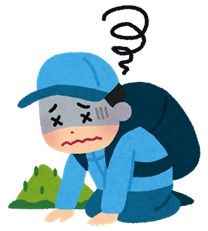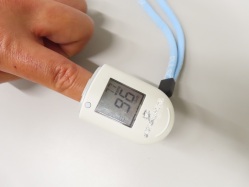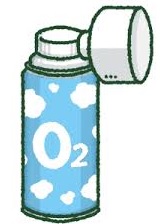Risk1: Altitude sickness
What happens if you get altitude sickness?
Symptoms of altitude sickness

- Altitude sickness is a condition caused by a low oxygen level in the blood.
- Continuing to climb will make the symptoms worse.
- Lack of sleep and poor physical condition tend to make symptoms worse.
<Main symptoms>
- Headache, dizziness, feeling faint
- Feeling tired and lethargic
- Loss of appetite, nausea, vomiting, etc.
- Fatal conditions such as cerebral edema and pulmonary edema may also occur.
Why does altitude sickness occur?
The higher the altitude, the atmospheric pressure as well as the oxygen concentration in the atmosphere decreases. In the case of Mt. Fuji, if the oxygen concentration at sea level is 100%, it is approximately 70% at 3,000m above sea level, and at the summit of Mt. Fuji (Kengamine peak) 3,776m the amount is approximately 65%. Inevitably, the oxygen taken into the lungs through breathing becomes diluted, and the oxygen saturation level (SpO2) in the blood decreases, causing various bodily disorders.
On the other hand, bodies can adapt to the altitude and maintain the necessary oxygen intake. Altitude sickness symptoms can be avoided or alleviated by climbing while properly acclimatizing to altitude. However, it depends on your constitution and physical condition. So if you are going in a group, please pay attention to the physical condition of other members.
Preventive measures
Before attempting to climb Mt. Fuji, it is recommended that you prepare by climbing other mountains to build up your stamina and improve your cardiopulmonary system so that you can continue walking all day. (It is recommended to do some trekking in your home country to warm up your legs before coming to Japan.)
Points to remember on the mountain
- Before climbing, take a break for about 1-2 hours near the 5th station to acclimate to the altitude.
- If you hold off on going to the toilet or refrain from drinking water, your metabolism will become low and you will be more likely to develop symptoms of altitude sickness. Therefore, drink water frequently.
- It is not recommended to fall asleep upon arrival at your hut. When you sleep, your breathing becomes shallow. If you are not acclimatized, your breathing becomes shallow and you are more likely to get altitude sickness. When you arrive at your hut, you should take about an hour to organize your luggage, take in the scenery, etc. while getting used to the altitude then take a good rest.
- Children have weak cardiopulmonary function, especially if they are climbing Mt. Fuji for the first time so they may not be able to get enough sleep. They are at greater risk of developing altitude sickness than adults. Pay close attention to your child, don't overdo it.
>> For walking tips and what to do if you get altitude sickness, check out "While Climbing"
<Brief memo>

Each group should have a pulse oximeter to measure their blood oxygen level. Record and manage the blood oxygen levels of the members regularly. This makes detecting signs of altitude sickness easier. In general, if the blood oxygen level falls below 90%, this is a sign of altitude sickness, and if it falls below 80%, it is dangerous (they should descend immediately).

Occasionally, there are climbers who breathe commercial canned oxygen while taking breaks.
It seems that climbers can breathe easily while they are inhaling canned oxygen. The moment they stop inhaling the oxygen cans, the oxygen concentration will return to that altitude. Using canned oxygen makes it easier to get altitude sickness.
The important thing is to acclimate your body to the oxygen concentration at that altitude. Only use canned oxygen temporarily when it's really painful.
Do not rely on it too much. Rather, take deep breaths to acclimate to the altitude. If you can't climb without canned oxygen, it's better to stop climbing and descend immediately.


